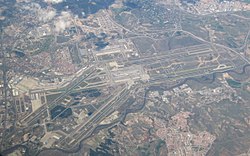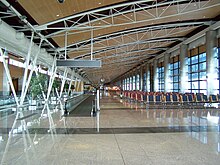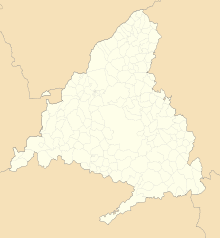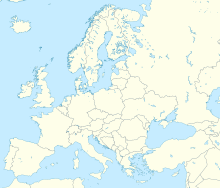
A | B | C | D | E | F | G | H | CH | I | J | K | L | M | N | O | P | Q | R | S | T | U | V | W | X | Y | Z | 0 | 1 | 2 | 3 | 4 | 5 | 6 | 7 | 8 | 9
Adolfo Suárez Madrid–Barajas Airport[1] Aeropuerto Adolfo Suárez Madrid–Barajas | |||||||||||||||||||||||
|---|---|---|---|---|---|---|---|---|---|---|---|---|---|---|---|---|---|---|---|---|---|---|---|
 | |||||||||||||||||||||||
 | |||||||||||||||||||||||
| Summary | |||||||||||||||||||||||
| Airport type | Public | ||||||||||||||||||||||
| Owner/Operator | Aena | ||||||||||||||||||||||
| Serves | Madrid metropolitan area | ||||||||||||||||||||||
| Location | District of Barajas, Madrid | ||||||||||||||||||||||
| Opened | 22 April 1931 | ||||||||||||||||||||||
| Hub for | |||||||||||||||||||||||
| Operating base for | |||||||||||||||||||||||
| Elevation AMSL | 609 m / 1,998 ft | ||||||||||||||||||||||
| Coordinates | 40°28′20″N 003°33′39″W / 40.47222°N 3.56083°W | ||||||||||||||||||||||
| Website | www | ||||||||||||||||||||||
| Map | |||||||||||||||||||||||
| Runways | |||||||||||||||||||||||
| |||||||||||||||||||||||
| Statistics (2023) | |||||||||||||||||||||||
| |||||||||||||||||||||||
Adolfo Suárez Madrid–Barajas Airport[a] (IATA: MAD, ICAO: LEMD) is the main international airport serving Madrid, the capital city of Spain. At 3,050 ha (7,500 acres) in area, it is the second-largest airport in Europe by physical size behind Paris Charles de Gaulle Airport.[5][6] In 2019, 61.8 million passengers travelled through Madrid–Barajas, making it the country's busiest airport as well as Europe's fifth-busiest.
The airport opened in 1931 and has grown to be one of Europe's most important aviation centres. Within the city limits of Madrid, it is 9 km (6 mi) from the city's financial district and 13 km (8 mi) northeast of the Puerta del Sol or Plaza Mayor de Madrid, Madrid's historic centre. The airport name derives from the adjacent district of Barajas, which has its own metro station on the same rail line serving the airport. Barajas serves as the gateway to the Iberian peninsula from the rest of Europe and the world and is a key link between Europe and Latin America. Following the death of former Spanish Prime Minister, Adolfo Suárez, in 2014, the Spanish Ministry of Public Works and Transport announced[7] that the airport was to be renamed Aeropuerto Adolfo Suárez, Madrid–Barajas. The airport is the primary hub and maintenance base for Iberia and Air Europa. Consequently, Iberia is responsible for more than 40% of Barajas's traffic. The airport has five passenger terminals: T1, T2, T3, T4 and T4S.
History
This section appears to be slanted towards recent events. (May 2023) |
Early years
The airport was constructed in 1927, opening to domestic and international air traffic on 22 April 1931, although regular commercial operations began two years later. A small terminal was constructed with a capacity for 30,000 passengers a year, in addition to several hangars and the building of the Avión Club. The first regular flight was established by Lineas Aéreas Postales Españolas (LAPE) with its route to Barcelona. In the 1930s, flights started to serve some European and African destinations, the first international flights from the airport.
Originally, the flight field was a large circle bordered in white with the name of Madrid in its interior, unpaved, consisting of land covered with natural grass. It was not until the 1940s that the flight field was paved and new runways were designed. The first runway which started operation in 1944 was 1,400 metres long and 45 metres wide.[8] By the end of the decade the airport had three runways, none of which exist today. In the late 1940s, scheduled flights to Latin America and the Philippines[9] started.
In the 1950s, the airport supported over half a million passengers, increasing to five runways and scheduled flights to New York City began. The National Terminal, currently T2, began construction in 1954 and opened later that year. In the Plan of Airports of 1957, Barajas Airport is classified as a first-class international airport. By the 1970s, large jets were landing at Barajas, and the growth of traffic mainly as a result of tourism exceeded forecasts. At the beginning of the decade, the airport reached the 1.2 million passengers, double that envisaged in the Plan of Airports of 1957.
In the 1970s, with the boom in tourism and the arrival of the Boeing 747, the airport reached 4 million passengers and began the construction of the international terminal (current T1). In 1974, Iberia, L.A.E. introduced the shuttle service between Madrid and Barcelona, a service with multiple daily frequencies and available without prior reservation.
The 1982 FIFA World Cup brought significant expansion and modernisation of the airport's two existing terminals.[8]
In the 1990s, the airport expanded further. In 1994, the first cargo terminal was constructed and the control tower was renovated. In 1997, it opened the North Dock, which is used as an exclusive terminal for Iberia's Schengen flights. In 1998, it inaugurated a new control tower, 71 m tall and then in 1999 the new South Dock opened, which implies an expansion of the international terminal. During this time, the distribution of the terminals changed: The south dock and most of the International Terminal were now called T1, the rest of the International Terminal and Domestic Terminal were now called T2 and the north dock was called T3.
In November 1998, the new runway 18R-36L started operations (replacing the previous 18–36), 4,400 m long, one of the largest in Europe under expansion plans called Major Barajas. In 2000, it began the construction of new terminals T4 and its satellite, T4S, designed by architects Antonio Lamela, Richard Rogers and Luis Vidal. Two parallel runways to the existing ones were also built.
Development since the 2000s
The new terminals and runways were completed in 2004, but were not in service until 5 February 2006.
Terminal 4, designed by Antonio Lamela, Richard Rogers and Luis Vidal, (winning team of the 2006 Stirling Prize) and TPS Engineers, (winning team of the 2006 IStructE Award for Commercial Structures)[10] was built by Ferrovial[11] and inaugurated on 5 February 2006. Terminal 4 is one of the world's largest airport terminals in terms of area, with 760,000 square meters (8,180,572 square feet) in separate landside and airside structures. It consists of a main building, T4 (470,000 m2) and a satellite building, T4S (290,000 m2), which are approximately 2 km apart. The new Terminal 4 is designed to give passengers a stress-free start to their journey. This is managed through careful use of illumination, with glass panes instead of walls and numerous skylights which allow natural light into the structure. With this new addition, Barajas is designed to handle 70 million passengers annually.
During the construction of Terminal 4, two more runways (15L/33R and 18L/36R) were constructed to aid in the flow of air traffic arriving and departing from Barajas. These runways were officially inaugurated on 5 February 2006 (together with the terminals), but had already been used on several occasions beforehand to test flight and air traffic manoeuvres. Thus, Barajas came to have four runways: two on a north–south axis and parallel to each other (separated by 1.3 km) and two on a northwest–southeast axis (and separated by 1.9 km). This allowed simultaneous takeoffs and landings into the airport, allowing 120 operations an hour (one takeoff or landing every 30 seconds).
Terminals 1, 2 and 3 are adjacent terminals that are home to SkyTeam and Star Alliance airlines. Terminal 4 is home to Iberia, its franchise Air Nostrum and all Oneworld partner airlines. Gate numbers are continuous in terminals 1, 2 and 3 (A1 to E89), but are separately numbered in terminal 4 (H, J, K and M, R, S, U in satellite building).
The Madrid–Barcelona air shuttle service, known as the "Puente Aéreo" (in Spanish), literally called "Air Bridge", used to be the busiest route between two EU airports[12] with 55 daily flights in 2012.[13] The schedule has been reduced since the February 2008 opening of the Madrid–Barcelona high-speed rail line which covers the distance in 2+1⁄2 hours. Subsequently, the route has been overtaken by London-Dublin and Paris-Toulouse.
On the morning of 30 December 2006, an explosion took place in the carpark building module D attached to Terminal 4. Authorities received a bomb threat at approximately 8:15 local time (7:15 GMT), with the caller stating that a car bomb carried with 800 kg of explosive would explode at 9:00 local time (8:00 GMT).[14] After receiving the warning, police were able to evacuate part of the airport.[15] Later, an anonymous caller stated that ETA claims responsibility for the bombing.[16] As a result of the explosion, two Ecuadorians who were sleeping in their cars died. The whole module D of the car park was levelled creating around 40,000 tonnes of debris. It took workers six days to recover the body of the second victim from the rubble.
In 2007, the airport processed more than 52 million passengers. Barajas was voted "Best Airport" in the 2008 Condé Nast Traveller Reader Awards.[17]
In December 2010, the Spanish government announced plans to tender Madrid–Barajas airport to companies in the private sector for a period of up to 40 years.[18]
On 27 January 2012, Spanair suspended all flights affecting Madrid–Barajas as well as other domestic and international connections.[19] On 20 September 2012, both runways 15/33 were renamed as 14R/32L (the longest) and 14L/32R (the shortest).
On 1 August 2015, the first scheduled Airbus A380 flight landed in Madrid-Barajas in a daily service to Dubai by Emirates.
Following the death of former Spanish Prime Minister, Adolfo Suárez, in 2014, the Spanish Ministry of Public Works and Transport announced[7] that the airport would be renamed Aeropuerto Adolfo Suárez, Madrid–Barajas. This renaming seeks recognition for Suárez's role as the first Prime Minister of Spain after the restoration of democracy and his key participation in the transition to democracy after the dictatorship of Francisco Franco.
In late 2018 and early 2019, Iberia renovated its two lounges in Terminal 4, the Dali and Velazquez lounges.
In December 2019, the airport's operator Aena announced plans to significantly expand and renovate the existing installations, increasing their yearly capacity from 70 to 80 million passengers and bridging the architectural gap between the original Terminals 1, 2 and 3 and the newer Terminal 4. The project has a budget of 750 million Euro and is set to be executed in the period from 2022 to 2026.[20]
Airlines and destinations
Passenger
The following airlines serve regular scheduled flights to and from Madrid:[21]
Cargo
Traffic and statistics












Passenger numbers
Graphs are unavailable due to technical issues. There is more info on Phabricator and on MediaWiki.org. |
| Passengers | Aircraft Movements | Cargo (tonnes) | |
|---|---|---|---|
| 2001 | 34,050,215 | 375,558 | 295,944 |
| 2002 | 33,915,302 | 368,029 | 295,711 |
| 2003 | 35,855,861 | 383,804 | 307,026 |
| 2004 | 38,718,614 | 401,503 | 341,177 |
| 2005 | 42,146,784 | 415,704 | 333,138 |
| 2006 | 45,799,983 | 434,959 | 325,702 |
| 2007 | 52,110,787 | 483,292 | 325,201 |
| 2008 | 50,846,494 | 469,746 | 329,187 |
| 2009 | 48,437,147 | 435,187 | 302,863 |
| 2010 | 49,863,504 | 433,683 | 373,380 |
| 2011 | 49,671,270 | 429,390 | 394,154 |
| 2012 | 45,195,014 | 373,185 | 359,362 |
| 2013 | 39,735,618 | 333,056 | 346,602 |
| 2014 | 41,833,374 | 342,601 | 366,645 |
| 2015 | 46,828,279 | 366,605 | 381,069 |
| 2016 | 50,420,583 | 378,150 | 415,774 |
| 2017 | 53,402,506 | 387,566 | 470,795 |
| 2018 | 57,891,340 | 409,832 | 518,858 |
| 2019 | 61,734,037 | 426,376 | 558,567 |
| 2020 | 17,112,389 | 165,740 | 401,133 |
| 2021 | 24,135,220 | 217,537 | 523,395 |
| 2022 | 50,633,652 | 351,906 | 566,372 |
| 2023 | 60,220,984 | 389,179 | 643,534 |
| Source: Aena Statistics[3] | |||




